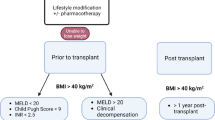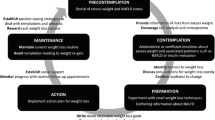Abstract
Background
Weight gain after liver transplantation (LT) is a predictor of major morbidity and mortality post-LT; however, there are no data regarding weight loss following LT. The current study evaluates the effectiveness of standard lifestyle intervention in LT recipients.
Methods
All adult LT recipients with body mass index (BMI) ≥ 25 kg/m2 who followed up in post-LT clinic from January 2013 to January 2016 were given standard lifestyle advice based on societal recommendations which was reinforced at 24 weeks. Patients were followed for a total of 48 weeks to assess the impact of such advice on weight. Primary outcome was achieving weight loss ≥ 5% of the body weight after 48 weeks of follow-up.
Results
A total of 151 patients with 86 (56.0%) overweight and 65 (44.0%) obese patients were enrolled in the study. The mean BMI at baseline increased from 30.2 ± 3.7 to 30.9 ± 4.3 kg/m2 at 48-week follow-up (p = 0.001). Over the course of study, 58 (38.4%) patients lost any weight and weight loss greater than 5% and 10% occurred in only 18 (11.9%) and 8 (5.3%) of the entire cohort, respectively. Higher level of education was associated with increased likelihood of weight loss (OR 9.8, 95% CI 2.6, 36.9, p = 0.001), while nonalcoholic steatohepatitis as etiology of liver disease (HR 3.7, 95% CI 1.4, 9.7, p = 0.007) was associated with weight gain.
Conclusion
The practice of office-based lifestyle intervention is ineffective in achieving clinically significant weight loss in LT recipients, and additional strategies are required to mitigate post-LT weight gain.


Similar content being viewed by others
Abbreviations
- BMI:
-
Body mass index
- CI:
-
Confidence interval
- CVD:
-
Cardiovascular disease
- HR:
-
Hazard ratio
- HS:
-
High school
- IQR:
-
Interquartile range
- LT:
-
Liver transplantation
- mTOR:
-
Mammalian target of rapamycin
- NASH:
-
Nonalcoholic steatohepatitis
- SPSS:
-
Statistical package for the social sciences
- VCU:
-
Virginia Commonwealth University
References
Martin P, DiMartini A, Feng S, Brown R, Fallon M. Evaluation for liver transplantation in adults: 2013 practice guideline by the American Association for the Study of Liver Diseases and the American Society of Transplantation. Hepatology. 2014;59:1144–1165.
Duffy JP, Kao K, Ko CY, et al. Long-term patient outcome and quality of life after liver transplantation: analysis of 20-year survivors. Ann Surg. 2010;252:652–661.
Åberg F, Gissler M, Karlsen TH, et al. Differences in long-term survival among liver transplant recipients and the general population: a population-based Nordic study. Hepatology. 2015;61:668–677.
Fussner LA, Heimbach JK, Fan C, et al. Cardiovascular disease after liver transplantation: when, what, and who is at risk. Liver Transpl Off Publ Am Assoc Study Liver Dis Int Liver Transpl Soc. 2015;21:889–896.
Johnston SD, Morris JK, Cramb R, Gunson BK, Neuberger J. Cardiovascular morbidity and mortality after orthotopic liver transplantation. Transplantation. 2002;73:901–906.
Vogt DP, Henderson JM, Carey WD, Barnes D. The long-term survival and causes of death in patients who survive at least 1 year after liver transplantation. Surgery. 2002;132:775–780. (discussion 780).
Klein S, Burke LE, Bray GA, et al. Clinical implications of obesity with specific focus on cardiovascular disease: a statement for professionals from the American Heart Association Council on Nutrition, Physical Activity, and Metabolism: endorsed by the American College of Cardiology Foundation. Circulation. 2004;110:2952–2967.
Poirier P, Giles TD, Bray GA, et al. Obesity and cardiovascular disease: pathophysiology, evaluation, and effect of weight loss: an update of the 1997 American Heart Association Scientific Statement on Obesity and Heart Disease from the Obesity Committee of the Council on Nutrition, Physical Activity, and Metabolism. Circulation. 2006;113:898–918.
Hubert HB, Feinleib M, McNamara PM, Castelli WP. Obesity as an independent risk factor for cardiovascular disease: a 26-year follow-up of participants in the Framingham Heart Study. Circulation. 1983;67:968–977.
Bhati C, Idowu MO, Sanyal AJ, et al. Long-term outcomes in patients undergoing liver transplantation for nonalcoholic steatohepatitis-related cirrhosis. Transplantation. 2017;101:1867–1874.
Richards J, Gunson B, Johnson J, Neuberger J. Weight gain and obesity after liver transplantation. Transpl Int. 2005;18:461–466.
Madhwal S, Atreja A, Albeldawi M, et al. Is liver transplantation a risk factor for cardiovascular disease? A meta-analysis of observational studies. Liver Transpl Off Publ Am Assoc Study Liver Dis Int Liver Transpl Soc. 2012;18:1140–1146.
Laryea M, Watt KD, Molinari M, et al. Metabolic syndrome in liver transplant recipients: prevalence and association with major vascular events. Liver Transpl. 2007;13:1109–1114.
Watt KDS, Pedersen RA, Kremers WK, Heimbach JK, Charlton MR. Evolution of causes and risk factors for mortality post-liver transplant: results of the NIDDK long-term follow-up study. Am J Transpl Off J Am Soc Transpl Am Soc Transpl Surg. 2010;10:1420–1427.
Nair S, Verma S, Thuluvath PJ. Obesity and its effect on survival in patients undergoing orthotopic liver transplantation in the United States. Hepatology. 2002;35:105–109.
Munoz SJ, Deems RO, Moritz MJ, Martin P, Jarrell BE, Maddrey WC. Hyperlipidemia and obesity after orthotopic liver transplantation. Transpl Proc. 1991;23:1480–1483.
Albeldawi M, Aggarwal A, Madhwal S, et al. Cumulative risk of cardiovascular events after orthotopic liver transplantation. Liver Transpl Off Publ Am Assoc Study Liver Dis Int Liver Transpl Soc. 2012;18:370–375.
Anastácio LR, Ferreira LG, de Sena Ribeiro H, Liboredo JC, Lima AS, Correia MITD. Metabolic syndrome after liver transplantation: prevalence and predictive factors. Nutrition. 2011;27:931–937.
Guckelberger O, Bechstein WO, Neuhaus R, et al. Cardiovascular risk factors in long-term follow-up after orthotopic liver transplantation. Clin Transpl. 1997;11:60–65.
Charlton M, Rinella M, Patel D, McCague K, Heimbach J, Watt K. Everolimus is associated with less weight gain than tacrolimus 2 years after liver transplantation: results of a randomized multicenter study. Transplantation. 2017;101:2873–2882.
Raynor HA, Champagne CM. Position of the academy of nutrition and dietetics: interventions for the treatment of overweight and obesity in adults. J Acad Nutr Diet. 2016;116:129–147.
Garvey WT, Mechanick JI, Brett EM, et al. American Association of Clinical Endocrinologists and American College of Endocrinology comprehensive clinical practice guidelines for medical care of patients with obesity. Endocr Pract. 2016;22:1–203.
Jensen MD, Ryan DH, Apovian CM, et al. 2013 AHA/ACC/TOS guideline for the management of overweight and obesity in adults: a report of the American College of Cardiology/American Heart Association Task Force on Practice Guidelines and The Obesity Society. Circulation.. 2014;129:S102–S138.
Dudekula A, Rachakonda V, Shaik B, Behari J. Weight loss in nonalcoholic Fatty liver disease patients in an ambulatory care setting is largely unsuccessful but correlates with frequency of clinic visits. PLoS ONE. 2014;9:e111808.
Stewart KE, Haller DL, Sargeant C, Levenson JL, Puri P, Sanyal AJ. Readiness for behaviour change in non-alcoholic fatty liver disease: implications for multidisciplinary care models. Liver Int Off J Int Assoc Study Liver. 2015;35:936–943.
Kaner EFS, Dickinson HO, Beyer F, et al. The effectiveness of brief alcohol interventions in primary care settings: a systematic review. Drug Alcohol Rev. 2009;28:301–323.
Whitlock EP, Polen MR, Green CA, Orleans T, Klein J, U.S. Preventive Services Task Force. Behavioral counseling interventions in primary care to reduce risky/harmful alcohol use by adults: a summary of the evidence for the U.S. Preventive Services Task Force. Ann Intern Med. 2004;140:557–568.
Mathurin P, Moreno C, Samuel D, Dumortier J, Salleron J, Durand F, et al. Early liver transplantation for severe alcoholic hepatitis. http://dx.doi.org/10.1056/NEJMoa1105703. 2011 [cited Jul 9, 2019 ]. https://www.nejm.org/doi/10.1056/NEJMoa1105703?url_ver=Z39.88-2003&rfr_id=ori%3Arid%3Acrossref.org&rfr_dat=cr_pub%3Dwww.ncbi.nlm.nih.gov.
Pageaux G-P, Bismuth M, Perney P, et al. Alcohol relapse after liver transplantation for alcoholic liver disease: does it matter? J Hepatol. 2003;38:629–634.
DiMartini A, Dew MA, Day N, et al. Trajectories of alcohol consumption following liver transplantation. Am J Transpl. 2010;10:2305–2312.
Obesity: preventing and managing the global epidemic. Report of a WHO consultation. World Health Organ Tech Rep Ser. 2000;894:i–xii, 1–253.
Clinical Guidelines on the Identification. Evaluation, and treatment of overweight and obesity in adults-the evidence report. National Institutes of Health. Obes Res. 1998;6:51S–209S.
Knowler WC, Barrett-Connor E, Fowler SE, et al. Reduction in the incidence of type 2 diabetes with lifestyle intervention or metformin. N Engl J Med. 2002;346:393–403.
Vilar-Gomez E, Martinez-Perez Y, Calzadilla-Bertot L, et al. Weight loss through lifestyle modification significantly reduces features of nonalcoholic steatohepatitis. Gastroenterology. 2015;149:378.e5. (quiz e14-15).
Ogden CL, Carroll MD, Kit BK, Flegal KM. Prevalence of childhood and adult obesity in the United States, 2011–2012. JAMA. 2014;311:806–814.
Prospective Studies Collaboration. Body-mass index and cause-specific mortality in 900000 adults: collaborative analyses of 57 prospective studies. Lancet. 2009;373:1083–1096.
Look AHEAD Research Group, Wing RR. Long-term effects of a lifestyle intervention on weight and cardiovascular risk factors in individuals with type 2 diabetes mellitus: four-year results of the Look AHEAD trial. Arch Intern Med. 2010;170:1566–1575.
Neter JE, Stam BE, Kok FJ, Grobbee DE, Geleijnse JM. Influence of weight reduction on blood pressure: a meta-analysis of randomized controlled trials. Hypertension. 2003;42:878–884.
Wadden TA, Berkowitz RI, Womble LG, et al. Randomized trial of lifestyle modification and pharmacotherapy for obesity. N Engl J Med. 2005;353:2111–2120.
Penn L, White M, Lindström J, den Boer AT, Blaak E, Eriksson JG, et al. Importance of weight loss maintenance and risk prediction in the prevention of type 2 diabetes: analysis of European Diabetes Prevention Study RCT. PLoS ONE [Internet]. 2013 [cited Mar 16, 2019];8. https://www.ncbi.nlm.nih.gov/pmc/articles/PMC3581561/.
Teixeira PJ, Silva MN, Coutinho SR, et al. Mediators of weight loss and weight loss maintenance in middle-aged women. Obesity. 2010;18:725–735.
Wing RR, Tate DF, Gorin AA, Raynor HA, Fava JL. A self-regulation program for maintenance of weight loss. N Engl J Med. 2006;355:1563–1571.
Svetkey LP, Stevens VJ, Brantley PJ, et al. Comparison of strategies for sustaining weight loss: the weight loss maintenance randomized controlled trial. JAMA. 2008;299:1139–1148.
Funding
No funding/financial support was utilized for the research and manuscript.
Author information
Authors and Affiliations
Contributions
Mohammad S. Siddiqui and Samarth Patel were involved in study concept and design; Fei-Pi Lin, John Laurenzo, and Joseph Clinton were involved in acquisition of data; Anchalia Chadrakumaran, Masoud Faridnia, and Jose Hernandez Roman analyzed the data; Samarth Patel and Mohammad B. Siddiqui drafted the manuscript; Salvatore Carbone, Danielle Kirkman, Susan Wolver, and Francesco Celi were involved in critical revision of the manuscript; Chandra Bhati and Mohammad S. Siddiqui supervised the study.
Corresponding author
Ethics declarations
Conflict of interest
All the authors of the manuscript certify that they have no conflict of interest.
Additional information
Publisher's Note
Springer Nature remains neutral with regard to jurisdictional claims in published maps and institutional affiliations.
Electronic supplementary material
Below is the link to the electronic supplementary material.
Rights and permissions
About this article
Cite this article
Patel, S.S., Siddiqui, M.B., Chadrakumaran, A. et al. Office-Based Weight Loss Counseling Is Ineffective in Liver Transplant Recipients. Dig Dis Sci 65, 639–646 (2020). https://doi.org/10.1007/s10620-019-05800-6
Received:
Accepted:
Published:
Issue Date:
DOI: https://doi.org/10.1007/s10620-019-05800-6




